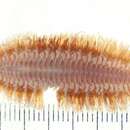Comprehensive Description
provided by Smithsonian Contributions to Zoology
Bylgides promamme (Malmgren, 1867)
Antinoe sarsi (Kinberg. MS) Malmgren, 1865:75 [part].
Antinoe promamme Malmgren, 1867:136 [part; records from Spitsbergen].
Polynoe badia Théel, 1879:18, pl. 1: figs. 9, 10, 12 [part; not P. badia variety; not fig. 11 (= B. groenlandicus)].
Polynoe (Laenilla) glaberrima Hansen. 1880:227, pl. 3: figs. 1–5, 8 [fide Loshamn, 1980].
Polynoe glaberrima Hansen, 1882:29, pl. 3: figs. 6–11 [fide Loshamn, 1980].
Antinoe badia.—Pettibone, 1956:547 [part; not record from Franz Josef Land].
Bylgides promamme Pettibone in Loshamn, 1980:209, figs. 103a–j, 104 [unpublished thesis].—Uschakov, 1982:153.
Bylgides prommame [sic].—Levenstein, 1981:34 [footnote].
MATERIAL EXAMINED.—KARA SEA: 74°30′N, 73°25′E, 28 m, sandy mud, sta 32 (no. 58, Théel), 3 Sep 1876, lectotype and paralectotype of P. badia (NRS 2371). 72°35′N, 77°30′E, 34 m, sandy mud, sta 170 (no. 30, Théel), 11 Aug 1875, paralectotype of P. badia (NRS 2373). 80°04′N, 76°52′E, “Litke” sta 79, 11 Aug 1948, 4 specimens (USNM 43596, exchange from ZIAS 357/5876, as Antinoella badia).
NORWAY: Spitsbergen Archipelago: Storfjorden, 9–33 m, fine clay, A.J. Malmgren, collector, lectotype of A. promamme (NRS 2601) and paralectotype (ZMUB). Genevra Bay, 21 Aug 1864, paralectotype of A. promamme (NRS 2603). Treurenburg Bay, 36–55 m, clay with stones, 5 paralectotypes of A. promamme (NRS 2607). Wyde Bay, 73 m, fine clay, Göes and Smitt, collectors, paralectotype of A. promamme (NRS 2604).
CANADA: Baffin Island: 65°43′N, 65°05′W, 132–245 m, D. Dean and J. Blake, collectors, HERO cr 3, sta 20E, 14 Aug 1968, 1 specimen (USNM 97534). Labrador: Halfway from Cape Mugford to Hebron, 110 m, Owen Bryant, collector, 28 Oct 1908, 2 specimens (USNM 15538). Lake Melville, St. Lewis Sound, Hebron Fjord, 59°24′N–62°21′N, 55°56.5′W-63°51′W, 31–183 m, mud, D.C. Nutt, collector, “Blue Dolphin,” 29 Jul to 8 Aug 1949, 11 Jul to 30 Aug 1950, 7 Jul to 26 Aug 1951, 31 Jul 1952, 27 specimens (USNM 21612–3, 22297–22300, 22302, 23738–42, 25035; ZIAS; as Antinoe badia by Pettibone, 1956).
UNITED STATES: Arctic Alaska: Off Point Barrow, 70°43′N, 150°01′W, 18 m, J.J. Gonor, collector, “Natchik” sta 7–9, 14 Aug 1963, 6 specimens (USNM 32131–3).
MEASUREMENTS.—Type Material: Lectotype of Antinoe promamme from Spitsbergen (NRS 2601) 44 mm long, 23 mm wide with setae, 36 segments; 5 paralectotypes (NRS 2607) 31–37 mm long, 12–17 mm wide, 33–37 segments. Lectotype of Polynoe badia from Kara Sea (NRS 2371) 48 mm long, 24 mm wide, 36 segments; paralectotype, with pharynx fully extended, 38 mm long, 28 mm wide, 25 segments plus regenerating posterior end of 5 small segments; young paralectotype (NRS 2373) 22 mm long, 11 mm wide, 35 segments, with pharynx fully extended.
Nontype Material: Additional 2 specimens from Kara Sea (USNM 43596) 36–40 mm long, 20–21 mm wide, 36 segments.
DESCRIPTION.—Body flattened, slightly tapered anteriorly and posteriorly, with very long parapodia, as long as body width (not including setae), and neurosetae longer than parapodia. Dorsum with 2 transverse ciliated bands per segment, extending onto bases of elytrophores and dorsal tubercles; ventrad with ciliated bands between ventral cirri and nephridial papillae. Without color or with 2 light tannish dorsal bands per segment. Elytra large, opaque, shiny, oval to subreniform, covering dorsum; elytral papillae present on most of exposed surface and along border, papillae widest basally with chitinous circular bases, contractile and variable in shape, tapering subdistally, with bulbous tips (Figure 8B,D). Dorsal cirri with long cylindrical cirrophores on posterior sides of notopodia, with long slender styles extending far beyond neurosetae, with rather long clavate papillae and filamentous tips; dorsal tubercles nodular (Figure 9D).
Prostomium bilobed, oval, with small distinct cephalic peaks; eyes rather small, anterior pair slightly larger than posterior pair, anterior to greatest width of prostomium; ceratophore of median antenna large, bulbous, in anterior notch of prostomium; style shorter than palps, with scattered, minute papillae, slight indication of subterminal enlargement, and filamentous tip; lateral antennae with ceratophores inserted ventrally, fused medially on basal part, with styles short, subulate, papillate; palps stout, tapered, minutely papillate (Figure 8A,C). Tentaculophores lateral to prostomium, with small acicular lobe and 2–4 stout, short notosetae on inner side; tentacular cirri similar to median antenna, subequal in length (Figure 8A,C); facial tubercle absent.
Second segment without nuchal lobe, with first pair of prominent elytrophores, biramous parapodia with rami subequal in length, and long ventral buccal cirri lateral to mouth, similar to tentacular cirri and longer than following ventral cirri; notosetae shorter than neurosetae, similar to those of following segments; upper neurosetae similar to those of following segments, lower neurosetae more slender, with spinous rows, tapering to slender sharp tips (Figures 8A, 9A,B). Pharynx with 9 pairs of border papillae and 2 pairs of amber-color jaws.
Parapodia biramous, with yellowish or golden setae. Notopodium shorter than neuropodium, rounded, with projecting acicular lobe on lower side; neuropodium with subconical postsetal lobe and longer presetal acicular lobe, with supraacicular digitiform projection (Figure 9B,D). Notosetae much stouter than neurosetae, forming radiating bundle, with numerous spinous rows; some notosetae short, slightly curved, with short bare tips, others nearly as long as neurosetae, straight, with longer bare tips. (Figure 9E). Neurosetae very numerous, slender, all with capillary tips, upper neurosetae longest, with long spinous region, large spinous rows basally, and fine hairs distally (Figure 9F); middle and lower neurosetae shorter, tapering to fine tips (Figure 9G,H). Ventral cirri short, tapered, with scattered clavate papillae (Figure 9C,D).
Nephridial papillae short, bulbous, beginning on segment 5. Pygidium with anus medial to parapodia of last segment, with pair of anal cirri.
DISTRIBUTION.—Spitsbergen Archipelago, Kara Sea, Arctic Alaska, Baffin Island, Labrador, in 9–245 meters.
- bibliographic citation
- Pettibone, Marian H. 1993. "Revision of some species referred to Antinoe, Antinoella, Antinoana, Bylgides, and Harmothoe (Polychaeta: Polynoidae: Harmothoinae)." Smithsonian Contributions to Zoology. 1-41. https://doi.org/10.5479/si.00810282.545

